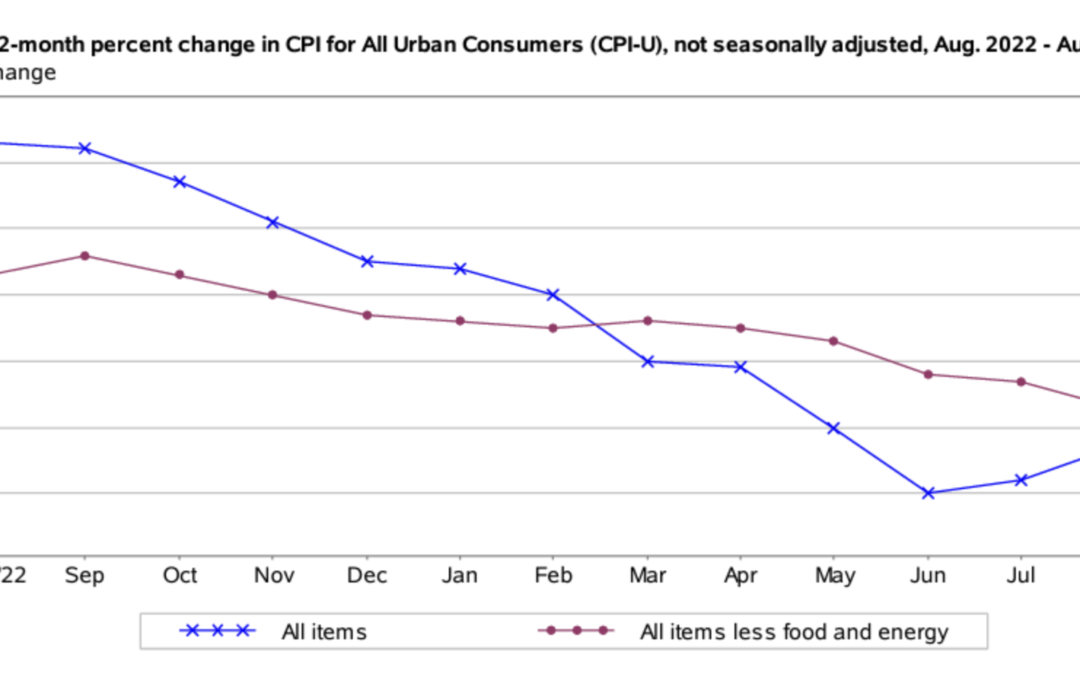
by Liam Hunt | Sep 13, 2023 | Monthly CPI Updates
The August 2023 report of the Consumer Price Index of All Urban Consumers (CPI-U) indicates that inflation jumped higher this month than any preceding month this year. The CPI-U increased by 0.6% on a seasonally unadjusted basis in August 2023, according to the Bureau of Labor Statistics report published September 13, 2023. Before seasonal adjustment, the year-over-year (Y-o-Y) inflation rate in the all-items index grew by 3.7%, marking a significant surge compared to July’s 3.2% and June’s 3.0% reading.
August’s CPI report came in hotter than expected according to a Dow Jones poll that found that most economists and analysts forecasted a 0.2% month-over-month increase.
Financial markets opened on Wednesday at a loss following August’s inflation news. The Dow Jones Industrial Average is down 32.46 points as of 10:30 a.m. on Wednesday, and the NASDAQ is down by 19.54 points. This marks the second consecutive month in which the U.S. headline inflation and core inflation rates have accelerated, following a gradual period of deceleration that lasted from mid-2022 to July of this year.
The main drivers of inflation according to August’s inflation report are gasoline prices (constituting over half the headline increase) as well as housing and shelter costs. Zooming out, present inflationary conditions are continuing to drift further away from the Federal Reserve’s target inflation rate of 2%—a policy aspiration that appears to be more and more out of reach without further rate hikes from the Federal Open Market Committee.
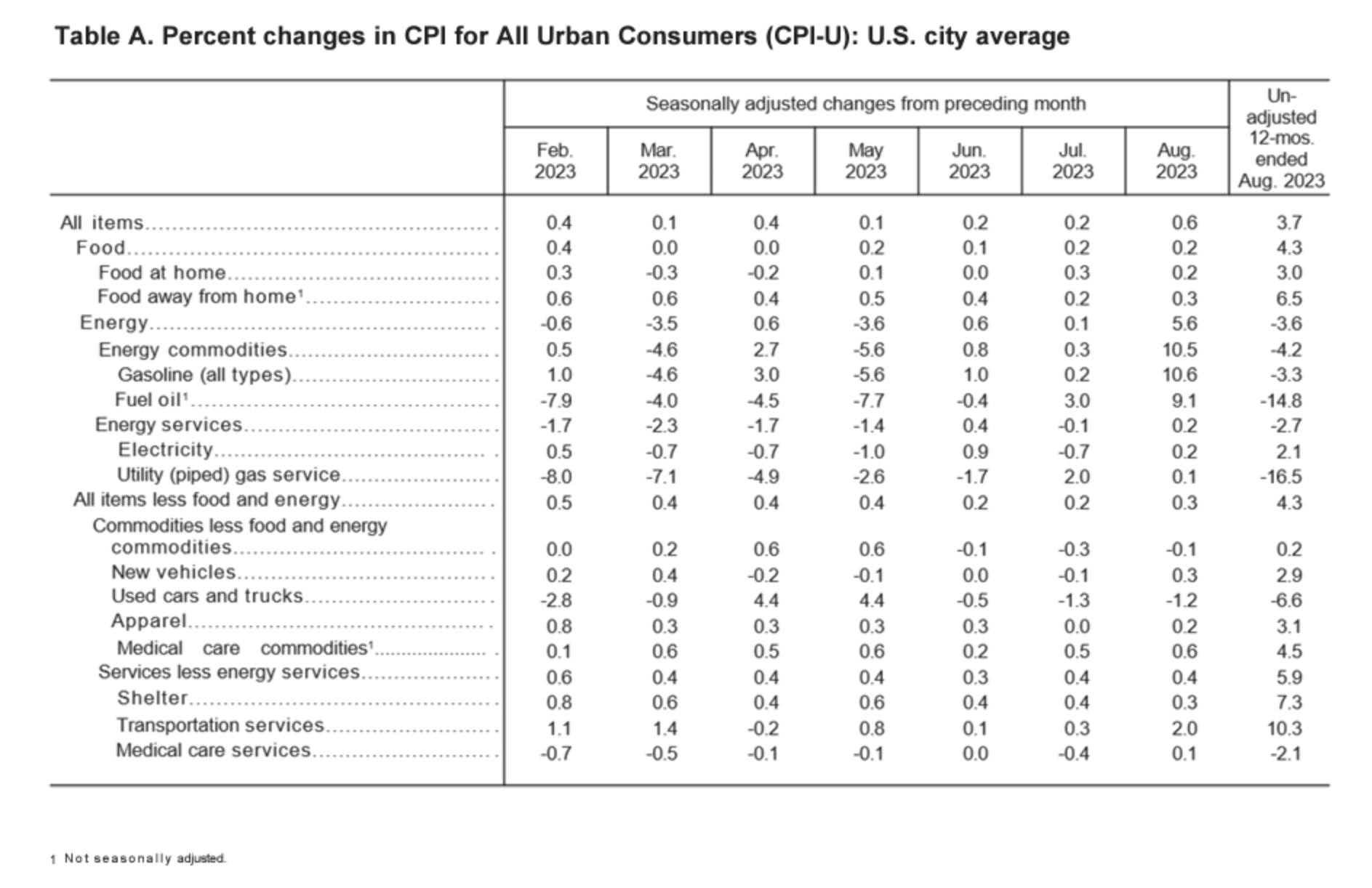
Source: Bureau of Labor Statistics
August’s monthly CPI figure far outpaces that of July (0.2) while also outpacing June’s reading (0.2). This provides concrete evidence that price acceleration is not only occurring, as it was in July, but it also gaining steam and appearing to have some degree of longevity. As depicted in the table above, the August 2023 CPI figure was largely driven by increases in energy commodities, specifically gasoline (10.6) and fuel oil (9.1), as well as transportation services (2.0) which rely heavily on energy resources. Due to base year effects, these energy increases arrive in stark contrast against July’s inflation report which found rapidly decreasing costs of fuel oil (-26.5), energy commodities (-20.3), and gasoline (-19.9).
Food Prices
In August, the food index rose by 0.2 percent, the same marginal increase seen in July. Notably, the index for food at home increased by 0.2 percent, representing a decline from July’s rise in the same index by 0.3 percent. Important price decreases include dairy and related products, which declined by 0.4 percent, as well as the nonalcoholic drinks and fruits and vegetable indices which both declined by 0.2 percent.
Year-over-year, the food away from home index 0.3 percent in August, a notable cool-off compared to July’s 0.7 percent. However, the food at home index rose by a considerably larger margin, hitting 3.0 percent growth this month.
Energy Prices
Following a modest gain of 0.1 percent in July, the energy index rose by a remarkable 5.6 percent in August. This is largely due to the gasoline index rising by 10.6 percent in August and the electricity index rising by 0.2 percent.
On an annual basis, however, the energy index fell by 3.6 percent. This indicates that short-run energy costs are rising while the longer-term trends indicate a decline from last year’s price levels.
Core August 2023 CPI
Regarding the core CPI data for August 2023 (inflation less food and energy), the index rose 0.3 percent month-over-month. This marks an increase from July and June’s core CPI acceleration of 0.2 percent. Below is an itemized breakdown of the main price fluctuations seen in August’s core CPI reading:
- Shelter index: +0.3% (+0.4% in July)
- Motor vehicle insurance: +2.4% (+2.0% in July)
- Rent index: +0.5% (+0.4% in July)
- Lodging away from home: (-3.0%)
- Prescription drugs index: +0.4%
- Hospital services: +0.7%
- Medical care index: +0.2% (-0.2% in July)
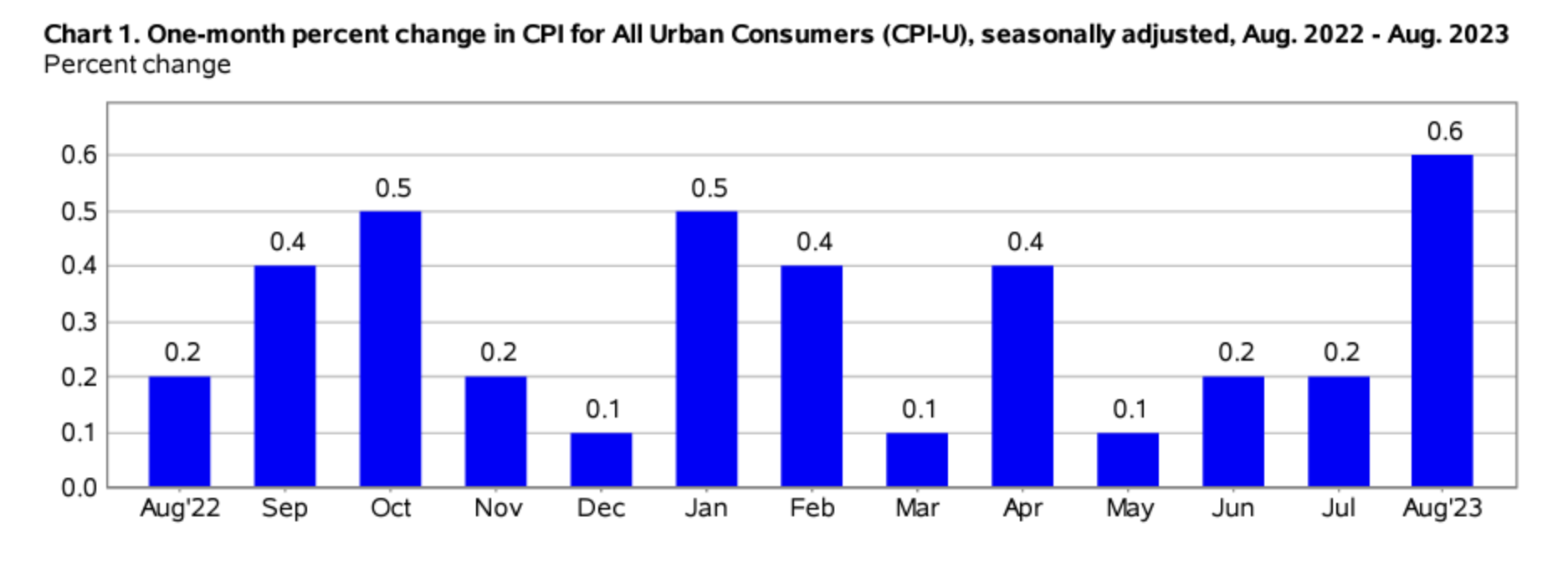
Source: Bureau of Labor Statistics
Seasonally Unadjusted CPI Data for August 2023
Before seasonal adjustments, the CPI-U for August 2023 increased (+3.7%) year-over-year, rising to an index level of 307.026. Since these figures are unadjusted, they include regular seasonal price fluctuations that generally occur by the same margins every year.
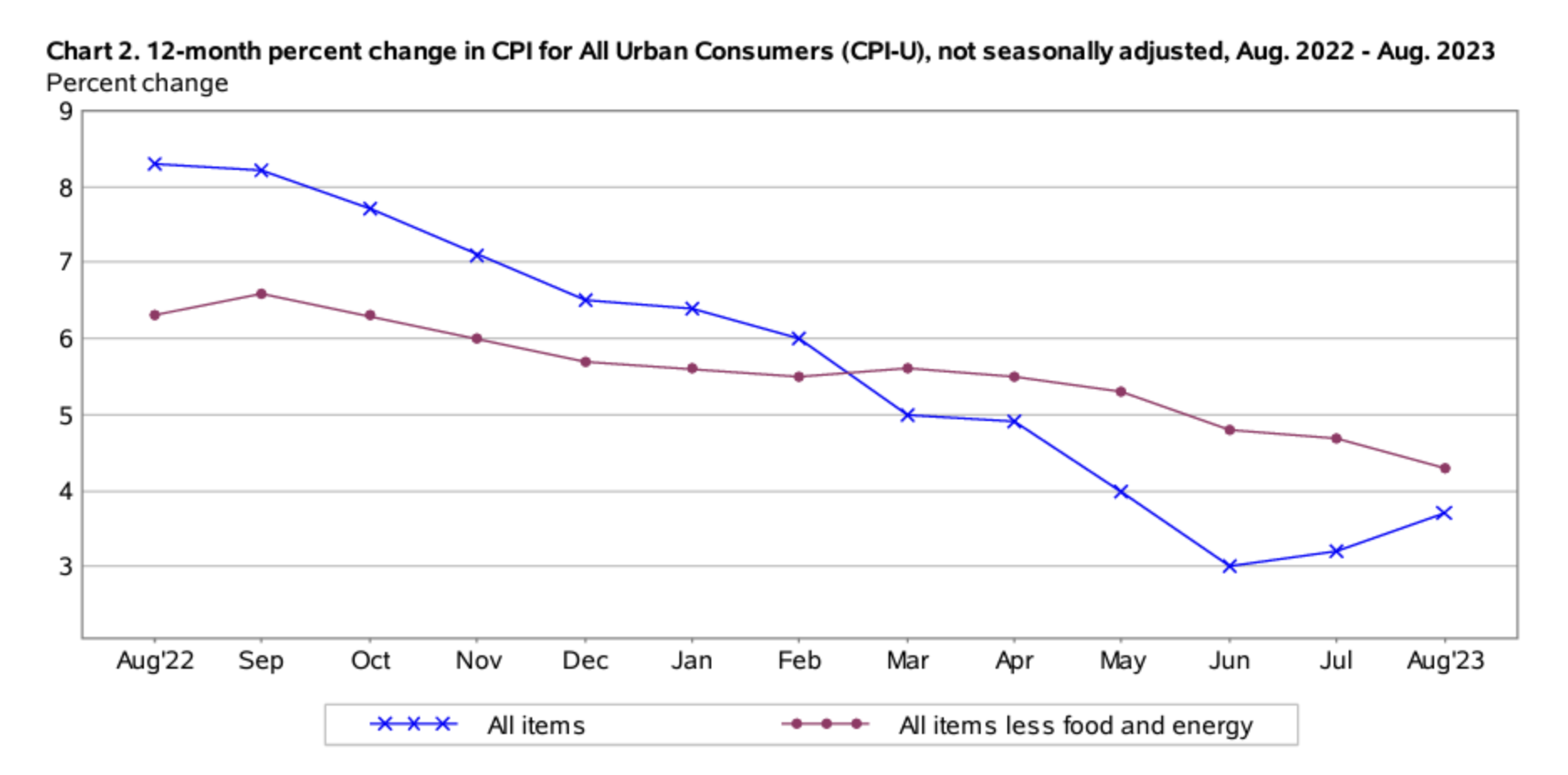
Source: Bureau of Labor Statistics
Get Ahead of Inflation This Autumn: Protect Your Wealth
August’s inflation numbers indicate that price increases are once again accelerating in America. The U.S. dollar’s value is declining day by day as more money enters circulation and consumer goods and services cost more to produce and get to market. The end result is that every American family has less purchasing power compared to the previous month, making it increasingly difficult to manage expenses, make ends meet, and save for retirement. All the while, personal debts are rising—in fact, America’s total credit card debt now exceeds $1 trillion.
Fortunately, you have the power to counteract the negative effects of inflation. Consider consulting with a financial expert to diversify your investment portfolio by including various asset types. These alternative investments have the potential to shield your savings from the diminishing value of the U.S. dollar.
During times of economic turbulence, like the 2020 stock market crash and the 2008 global financial crisis, historical data suggests that assets like gold and silver have outperformed conventional securities. For many, gold serves as a safeguard against inflation, offering a dependable store of value when traditional assets falter. Notably, accomplished investors such as Ray Dalio and Kevin O’Leary regard it as a valuable risk management tool.
Interested in embarking on a gold or silver investment journey? You can get started by establishing an account with one of the top-rated gold IRA service providers. In the meantime, stay vigilant about inflation trends in the coming months. Our complimentary CPI inflation calculator tool is accessible to help you monitor how inflation affects your purchasing power within your household. It effectively tracks the erosive impact of inflation, keeping you well-informed when preparing for your financial future.
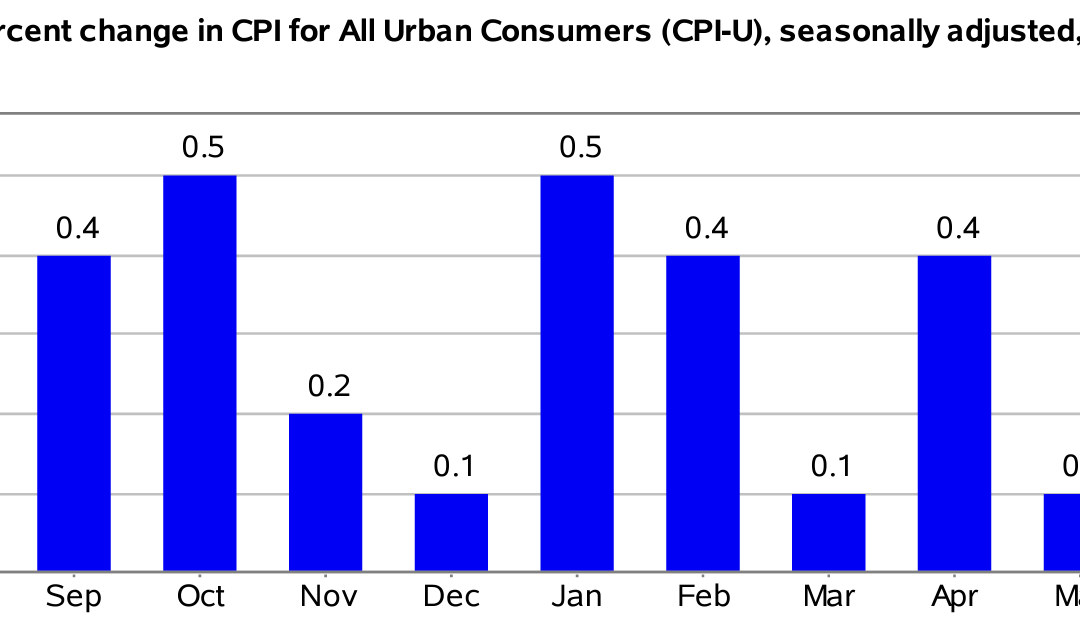
by Liam Hunt | Aug 10, 2023 | Monthly CPI Updates
According to the latest report of the Consumer Price Index of All Urban Consumers (CPI-U), inflation remains down by two-thirds from its mid-2022 peak. The CPI-U increased by 0.2% on a seasonally unadjusted basis in July 2023, according to the Bureau of Labor Statistics report published July 12. Year-over-year, before seasonal adjustment the all-items index grew by 3.2%, constituting a marked acceleration in the CPI-U from June’s 3.0% reading.
July’s better-than-expected headline CPI reading, while higher than the previous month by 0.2 percentage points, is lower than the 3.3% reading that most economic analysts expected heading into Thursday’s report.
Soft inflation data caused an immediate positive reaction in the markets, with the Dow Jones Industrial Average popping up +0.73% by mid-morning Thursday, constituting a 200-point gain. In general, inflation rates in the U.S. are continuing to decelerate, indicating that the Federal Reserve’s hawkish interest rate policy is working as intended—with the most recent 0.25 basis point increase having been announced only two weeks ago, during the July 26 Federal Open Market Committee press conference.
While many line items in the July 2023 CPI report suggest that prices are not increasing, especially concerning energy and utility prices, there is ample evidence that housing and lodging costs are the main drivers of inflation in America. All in all, July’s 2023 CPI numbers remain well over 50% higher than the Fed’s target inflation rate of 2%—a target that may prove unobtainable without further rate hikes from the central bank.

Source: Bureau of Labor Statistics
July’s monthly CPI figure matched the previous month (0.2) while outpacing May’s reading (0.1). However, May’s unusually low month-over-month CPI reading was an anomaly largely attributable to the base-year effect seen between April 2021 and 2022 due to the Russian invasion of Ukraine, an event that saw immediate and large-scale price increases in oil, gas, and certain natural resources. These prices then partially settled in the subsequent months.
As depicted in the table above, the June 2023 CPI figure was largely driven by increases in transportation (9.0), shelter (7.7), and food away from home (7.1). Downward pressure on the CPI was exerted by rapidly decreasing costs of fuel oil (-26.5), energy commodities (-20.3), and gasoline (-19.9).
Food Prices
The food index rose 0.2 percent in June after rising only 0.1 percent in June and increasing 0.1 percent in May, representing a core market segment where consumer prices rose compared to the month prior. Notably, the beef index rose 2.4 percent while eggs, fish, and poultry rose by a more modest 0.5 percent. The same reading (0.5%) is true of milk and dairy products as well.
Year-over-year, the food away from home index rose 7.1 percent in July 2023, whereas the food at home index rose by 3.6 percent—nearly half the price acceleration seen in restaurants and cafes in America.
Energy Prices
The energy index rose in July (0.1%) after rising rapidly in June (0.6%). The natural gas index spiked 2.0 percent on the month after seeing five consecutive monthly decreases. The good news for American households is that the energy index fell (-12.5%) year-over-year in July and the gasoline indexed fared even better—dropping a remarkable 19.9 percent on a 12-month span. Other large-scale price decreases were seen in both the natural gas and fuel oil indices.
Core July 2023 CPI
Regarding the core CPI data for July 2023 (inflation less food and energy), the index rose 0.2% month-over-month in July, maintaining the same acceleration rate as June. Below is an itemized breakdown of the main price fluctuations seen within July’s core CPI reading:
- Shelter index: +0.4% (+0.4% in June)
- Motor vehicle insurance: +2.0% (+1.7% in June)
- Rent index: +0.4%
- Lodging away from home: (-0.3%)
- Airline fares index: (-8.1%)
- Used cars and trucks: (-1.3%; +4.4% in June)
- Medical care index: (-0.2%)
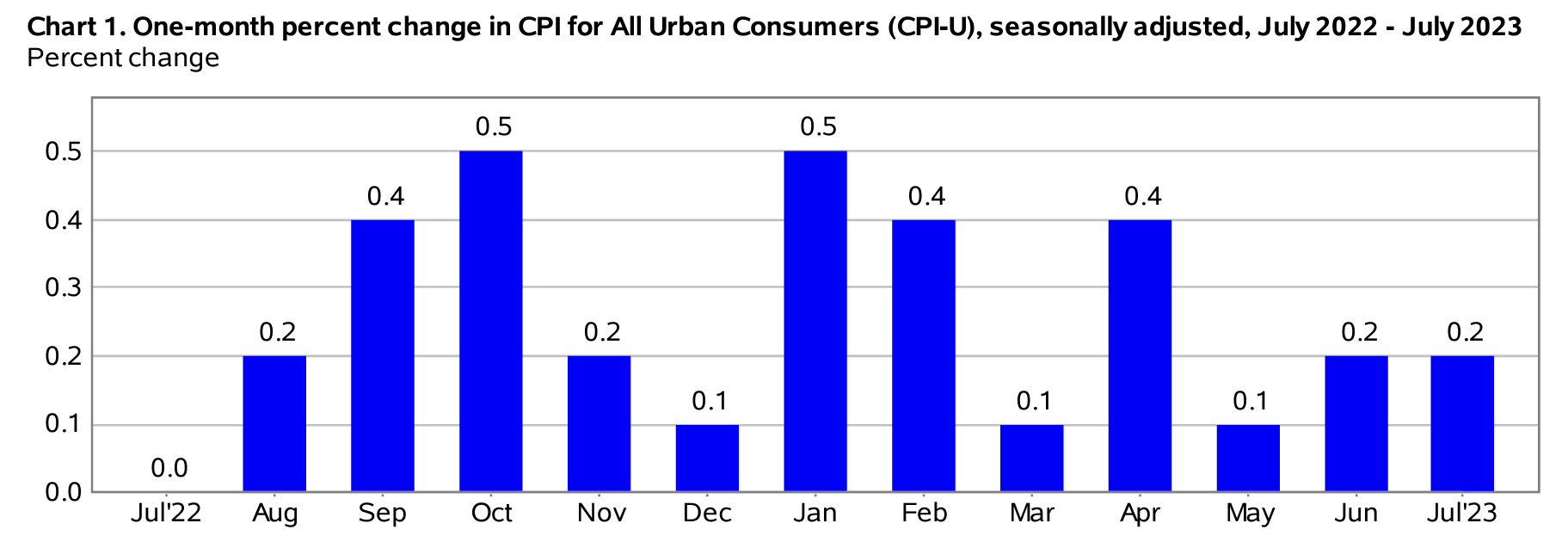
Source: Bureau of Labor Statistics
Seasonally Unadjusted CPI Data for July 2023
Before seasonal adjustments, the CPI-U for July 2023 increased (+3.2%) year-over-year and increased by 0.2 percent on the month, rising to an index level of 305.691. Since these figures are unadjusted, they include regular seasonal price fluctuations that generally occur by the same margins every year.
Now Is The Time to Protect Your Wealth
While the July Consumer Price Index report might appear positive, the U.S. dollar’s value is steadily declining day by day. The outcome? Countless American families now have reduced purchasing power compared to the previous month, making it increasingly difficult to manage their expenses. Though inflation is becoming more familiar, the average American household has actually seen its yearly wages decrease by around $7,400 due to inflation and interest rate increases since 2021.
The good news is that we can counteract the negative impacts of inflation. You might want to consider talking to your financial advisor about adding different types of assets to your investment portfolio. These alternative assets could potentially help safeguard your savings from the erosion of the U.S. dollar’s value.
Throughout various economic downturns and crises, such as the 2020 stock market crash and the 2008 global financial crisis, gold and silver have historically performed better than conventional securities. For many people, gold acts as a defense against inflation, providing a reliable store of value when traditional assets lose their worth. It’s no surprise that accomplished investors like Ray Dalio and Kevin O’Leary view it as a tool for managing risks.
Interested in starting to invest in gold or silver? You can begin by opening an account with one of the top-rated gold IRA service providers. While you’re at it, stay informed about inflation developments in the upcoming months. Our free CPI inflation calculator tool is available to help you monitor how inflation is impacting your household’s purchasing power. It effectively tracks the erosive effects of inflation, allowing you to stay in the know.
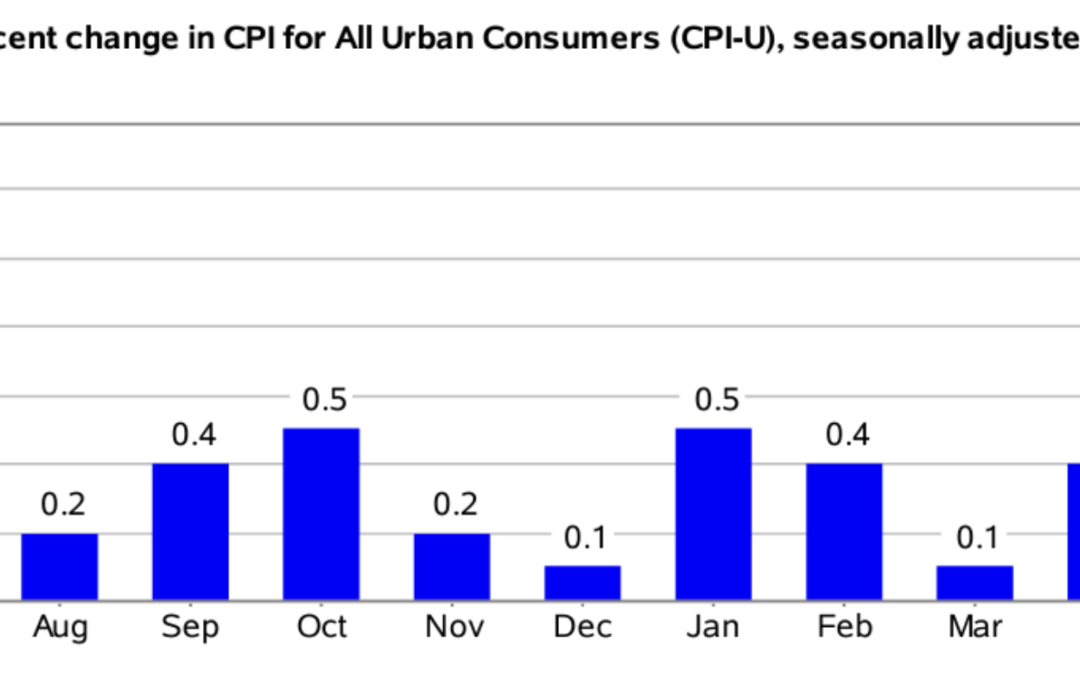
by Liam Hunt | Jul 12, 2023 | Inflation, Monthly CPI Updates
The Consumer Price Index for All Urban Consumers (CPI-U) increased by 0.2% on a seasonally unadjusted basis in June 2023, according to the Bureau of Labor Statistics report published July 12. Year-over-year, before seasonal adjustment the all-items index grew by 3.0%, constituting a major deceleration in the CPI-U from May’s 4.0% reading.
June’s rosy CPI report is the lowest in two years, when March 2021’s CPI report came in at 2.6% year-over-year. This month’s CPI report fared better than economists and investors expected, causing an immediate surge in the benchmark stock market indices on the morning of July 12. The rapid deceleration of the inflation rate in the U.S. is being taken by many as evidence that the Federal Reserve’s hawkish interest rate policy is performing as intended by successfully reining in inflation.
Nonetheless, the June 2023 CPI numbers are still 50% higher than the Fed’s target inflation rate of 2%—a figure that some doubt is possible to achieve without future rate hikes from the central bank.
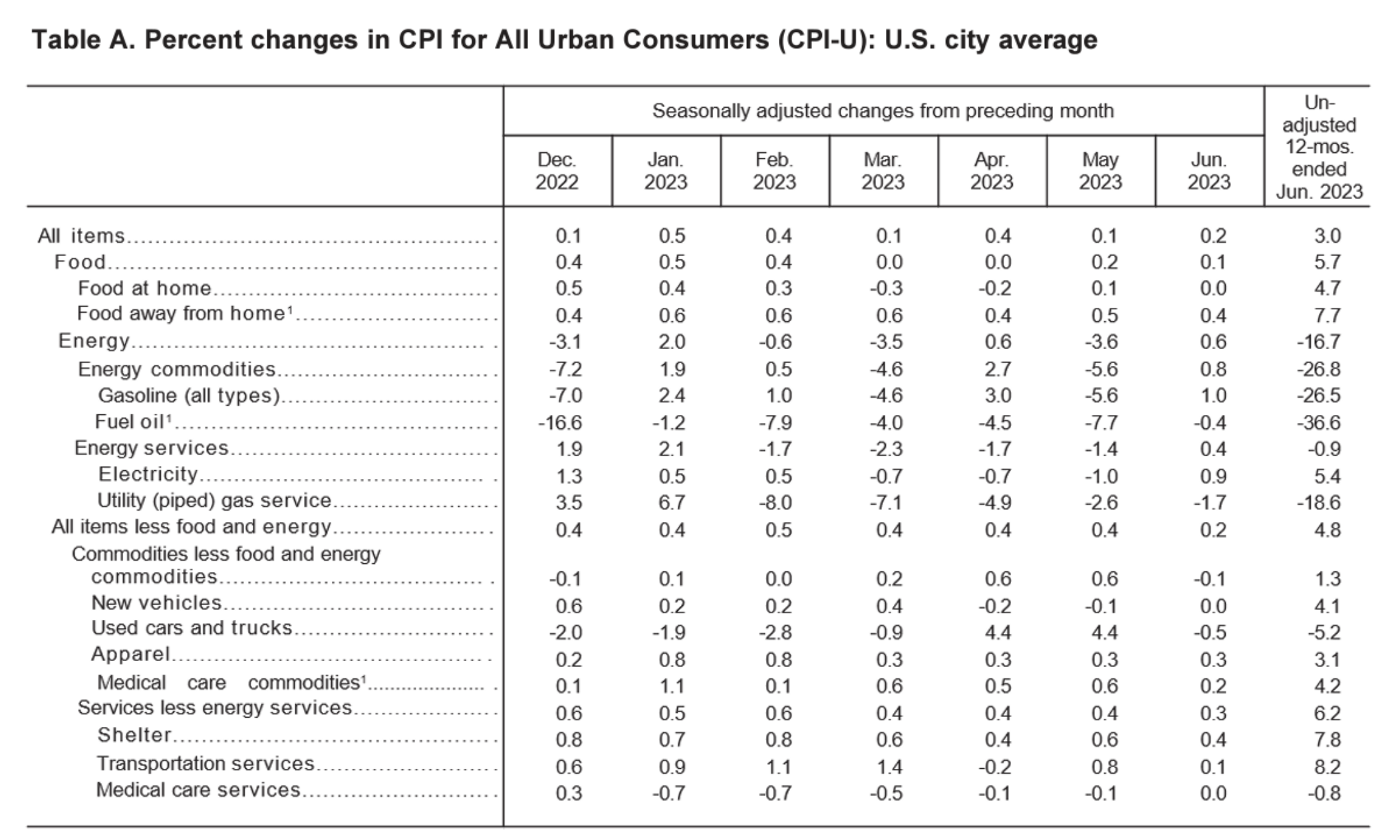
Source: Bureau of Labor Statistics
June’s monthly CPI figure (0.2) came in higher than the previous month’s (0.1). The previous month’s “blip” in the monthly CPI report can be largely explained by the base-year effect seen between April 2021 and 2022 due to the Russian invasion of Ukraine, an event that saw immediate and large-scale price increases in oil, gas, and certain natural resources. These prices then partially settled in the subsequent months.
As depicted in the table above, the June 2023 CPI figure was largely driven by increases in consumer energy commodities and overall energy price increases.
Food Prices
The food index rose 0.1 percent in June after going unchanged in April and increasing 0.1 percent in May, representing a core market segment where consumer prices stagnated compared to the month prior. Notably, egg prices fell 7.3 percent in June after falling significantly in May—in total, egg prices have fallen by nearly half since the start of the year following a devastating avian flu outbreak that killed 43 million hens in 2022.
The meats, poultry, and eggs index dropped by 0.4 percent in June on the heels of an even large 1.2 percent decrease in May(-1.2%). However, year-over-year, the food at home index has risen by 4.7 percent, meaning your total grocery bill today compared to June 2022 is nearly 5 percent higher on average.
Energy Prices
The energy index rose in June May (0.6%) after falling in May. Notably, gasoline prices increased by 1.0 percent after dropping 5.6 percent in May. Concurrently, natural gas fell by 1.7 percent in June, marking the third consecutive month of natural gas price cuts. Fuel oil prices also fell, by about 0.4 percent in June.
Overall, energy costs inched up in June, constituting a minor deviation in the general trendline of falling energy prices ongoing since March. Year-over-year, energy prices are up 16.7 percent over 12 months.
Core June 2023 CPI
Regarding the core CPI data for June 2023 (inflation less food and energy), the index rose 0.2% month-over-month in June, down from a 0.6 percent acceleration in May. Below is an itemized breakdown of the main price fluctuations seen within June’s core CPI reading:
- Shelter index: +0.4% (+0.6% in May)
- Used cars and trucks: +4.4 (+4.4% in May)
- Lodging away from home: (-2.0%) (+1.8% in May)
- Medical care index: +0.1% (unchanged from May)
- Household furnishings: +3.6%
- Airline fares: (-8.1%) (-3.0% in May)
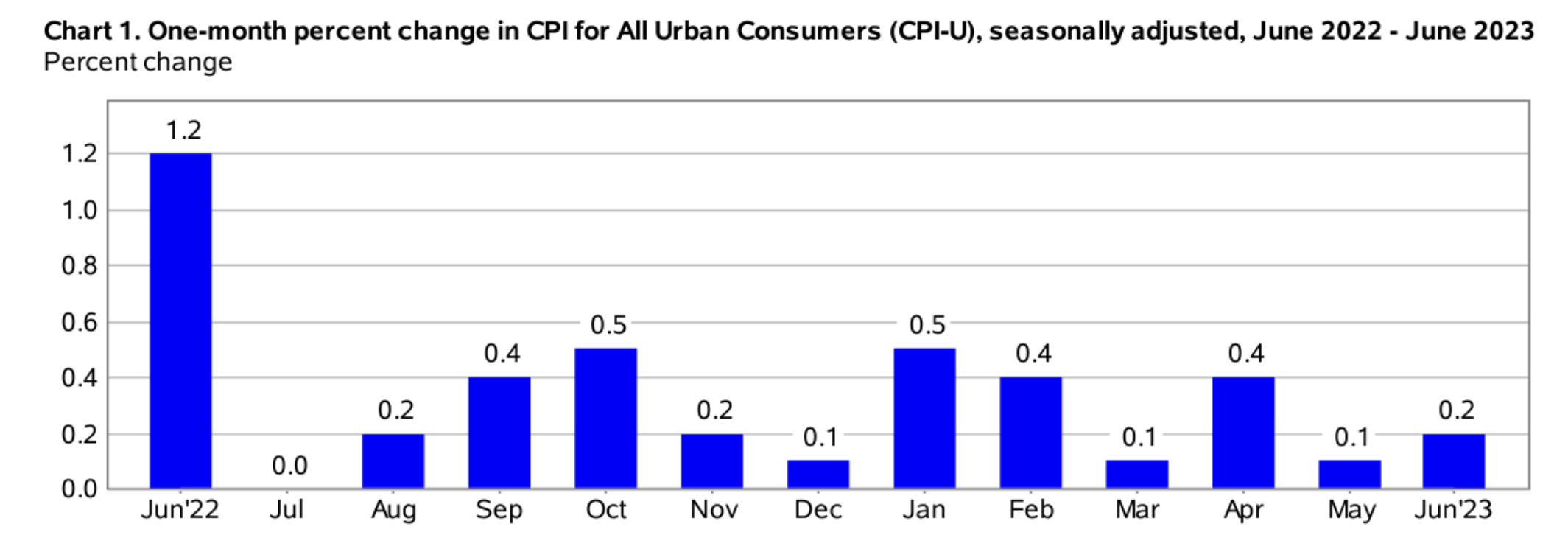
Source: Bureau of Labor Statistics
Seasonally Unadjusted CPI Data for June 2023
Before seasonal adjustments, the CPI-U for June 2023 increased (+0.3%) for the month, rising to an index level of 305.109. Since these figures are unadjusted, they include regular seasonal price fluctuations that generally occur by the same margins every year.
Now Is The Time to Protect Your Wealth
Although June’s CPI report may seem rosy, the U.S. dollar is only continuing to lose value by the day. The result? Millions of American families with less purchasing power than they had the month prior, making it that much harder to make ends meet. While inflation is beginning to enter familiar territory, the average American household has lost the equivalent of $7,400 in annual wages due to inflation and rate hikes since 2021.
Luckily, we can mitigate the adverse effects of inflation. Consider speaking to your financial advisor about diversifying your investment portfolio with alternative assets that may help insulate your savings from the devaluation of the U.S. dollar.
Gold and silver have historically outperformed traditional securities during most recessions and economic crises, including the 2020 stock market crash and the 2008 global financial crisis. For many, gold functions as an inflation hedge, providing a much-needed store of value when fiat assets depreciate. No wonder why it’s sought after by many successful investors like Ray Dalio and Kevin O’Leary as a risk management tool.
Want to get started investing in silver or gold? Open an account today with one of the best-rated gold IRA service providers. While you’re at it, stay up-to-date on inflation news in the months ahead. You can easily keep tabs on how inflation is holding back your household’s purchasing power by using our free CPI inflation calculator tool that tracks the wealth-eroding effects of inflation.
by Liam Hunt | Jun 13, 2023 | Monthly CPI Updates
The Consumer Price Index for All Urban Consumers (CPI-U) increased by 0.1% on a seasonally unadjusted basis in May 2023, according to the Bureau of Labor Statistics report published June 13. Year-over-year, before seasonal adjustment the all-items index grew by 4.0%, constituting a major deceleration in the CPI-U from April’s 4.9% reading.
May’s rosy CPI report is the lowest since March 2021’s 2.6% reading, at a time when pandemic-era inflation was just getting started. This month’s CPI report came in far better than expected by many economists and experts. For instance, Morningstar expected only a “little slowdown” in May’s inflation rate compared to April, which would be an understatement when describing May’s nearly 20% reduction in monthly inflation. As a result, financial markets rose and priced in a near-guarantee that the Federal Reserve will not raise interest rates later this week.
In short, the May 2023 CPI report indicates that the Federal Reserve’s monetary tightening policy is working as intended. However, today’s CPI numbers are still double the Fed’s target inflation rate of 2%—an aspirational figure that may be difficult or outright impossible to reach without future rate hikes.
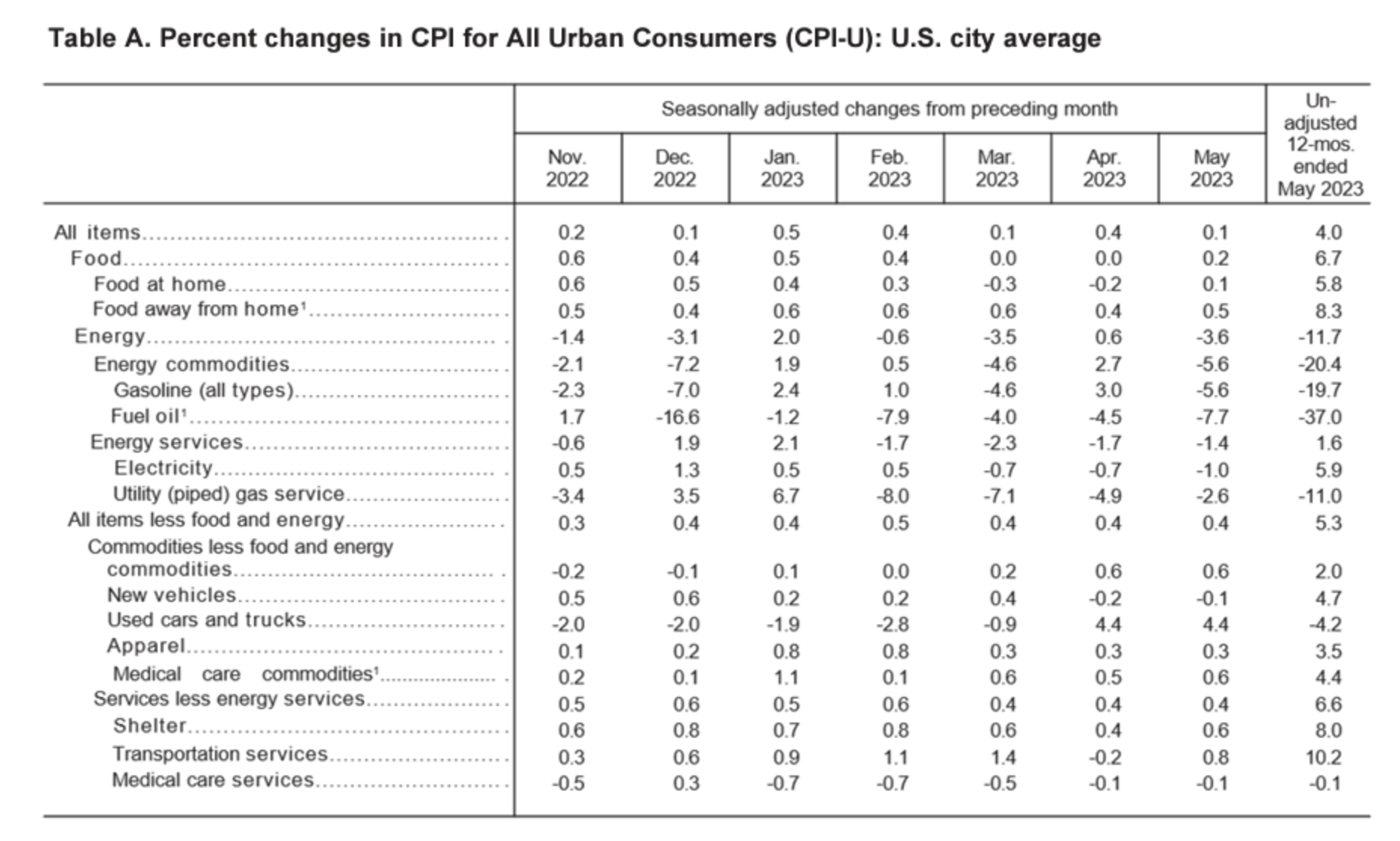
Source: Bureau of Labor Statistics
May’s impressive monthly CPI figure (0.1) came in significantly lower than the previous month’s (0.4) while matching the month-to-month reading in March. The April “blip” in the monthly CPI report can be largely explained by the base-year effect seen between April 2021 and 2022 due to the Russian invasion of Ukraine, an event that saw immediate and large-scale price increases in oil, gas, and certain natural resources. These prices then partially settled in the subsequent months.
As depicted in the table above, the May 2023 CPI figure was largely driven by increases in consumer costs for logistics and transportation services, shelter, and food away from home.
Food Prices
The food index rose 0.2 percent in May after going unchanged in April, representing a core market segment where consumer prices rose compared to the month prior. Regarding food at home, the index slightly increased (0.1%) after decreasing (-0.2%) in April. Half of the grocery store food price indexes increased in May as well, most notably the fruits and vegetables index (1.3%). However, the meats, poultry, and eggs index dropped (-1.2%), with strong price decreases in eggs (-13.8%). This marks the lowest monthly decrease in egg costs in over 70 years (January 1951).
On the year, the food away from home index rose by 8.3 percent, with full-service meals rising 6.8 percent and limited-service meals rising 8.0 percent. Over the same period, food at home rose 5.8 percent on the year with cereals and bakery items asserting the most upward pressure on the index (10.7%).
Energy Prices
The energy index fell in May (-3.6%) after rising in April (+0.6%) and falling in March (-3.5%). Notably, gasoline prices dropped (-5.6%) after a considerable increase in the previous month (+3.0%). Concurrently, natural gas fell by 2.6 percent in May, continuing on price decreases over the previous two months. Fuel oil and electricity prices also fell, by 7.7 percent and 1.0 percent, respectively.
In sum, all energy costs fell in May, which mostly added to a continuing trendline of falling energy prices ongoing since March. However, electricity prices are still up on a 12-month basis, rising by 5.9 percent since May 2022.
Core May 2023 CPI
Regarding the core CPI data for May 2023 (inflation less food and energy), the index rose 0.4% month-over-month in May, matching its pace in both April and March. Below is an itemized breakdown of the main price fluctuations seen within May’s core CPI reading:
- Shelter index: +0.6% (+0.4% in April)
- Used cars and trucks: +4.4 (+4.4% in April)
- Motor vehicle insurance: +2.0%
- Rent index: +0.5%
- Lodging away from home: +1.8%
- Medical care index: +0.1% (unchanged in April)
- Household furnishings: (-0.6%)
- Airline fares: (-3.0%)
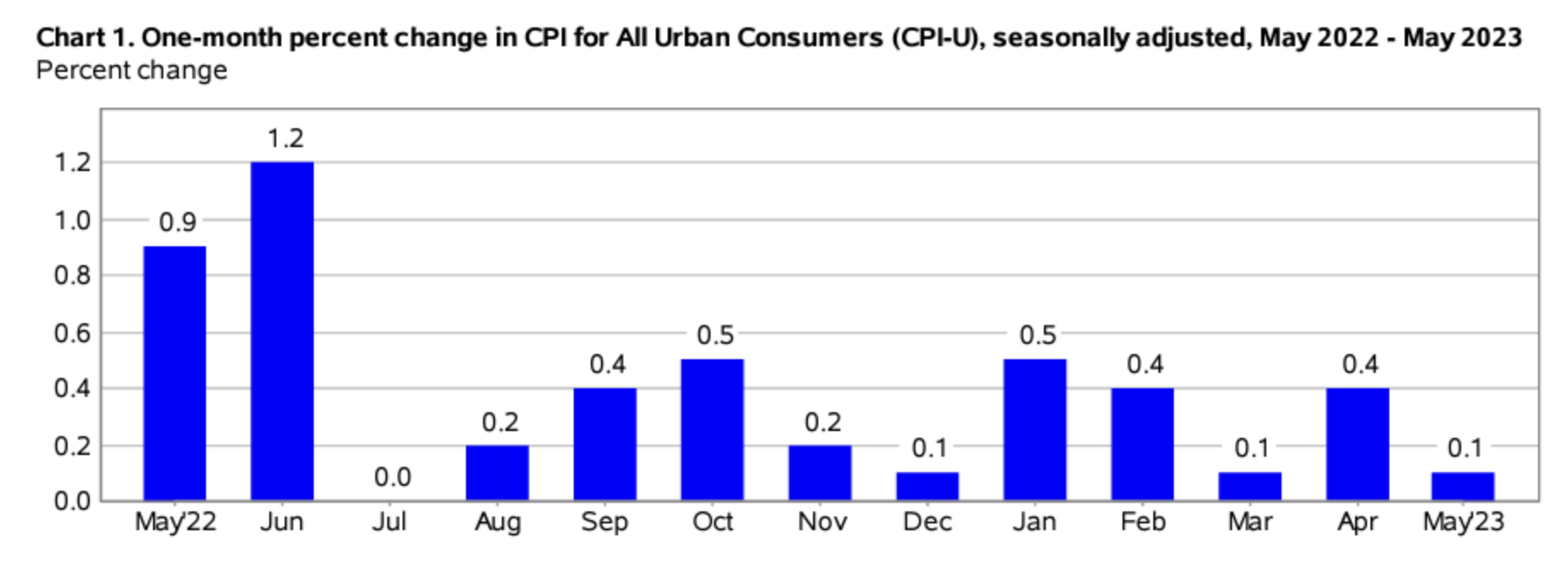
Source: Bureau of Labor Statistics
Seasonally Unadjusted CPI Data for May 2023
Before seasonal adjustments, the CPI-U for May 2023 increased (+0.3%) for the month, rising to an index level of 304.127. Since these figures are unadjusted, they include regular seasonal price fluctuations that generally occur at the same time and by the same margins every year.
This Year, Guard Your Wealth From Inflation
May’s CPI report may seem optimistic, but the U.S. dollar is continuing to decline in value at twice the speed that the Federal Reserve would prefer. The result is that American families have less purchasing power than they did last year, and their paychecks haven’t kept pace. While inflation is coming back down to Earth, the average American household has lost the equivalent of $7,400 in annual wages due to inflation and rate hikes.
Fortunately, you can mitigate the adverse effects of inflation. Consider speaking to your financial advisor about diversifying your investment portfolio with alternative assets that may help insulate your savings from the devaluation of the U.S. dollar.
Scarce physical assets such as gold and silver have historically outperformed traditional securities during most recessions, economic crises, and periods of high inflation. For many investors, gold functions as an inflation hedge, providing a much-needed store of value when fiat assets depreciate. As such, it is sought after by many notable investors—like Ray Dalio and Kevin O’Leary—as a strategic risk management tool.
To get started with gold or silver investing, open an account today with one of the best-rated gold IRA service providers. While you’re at it, be sure to stay up-to-date on inflation news in the months ahead. You can easily keep tabs on how inflation is impacting your household’s purchasing power by using our free CPI inflation calculator tool that tracks the effects of inflation on your purchasing power.
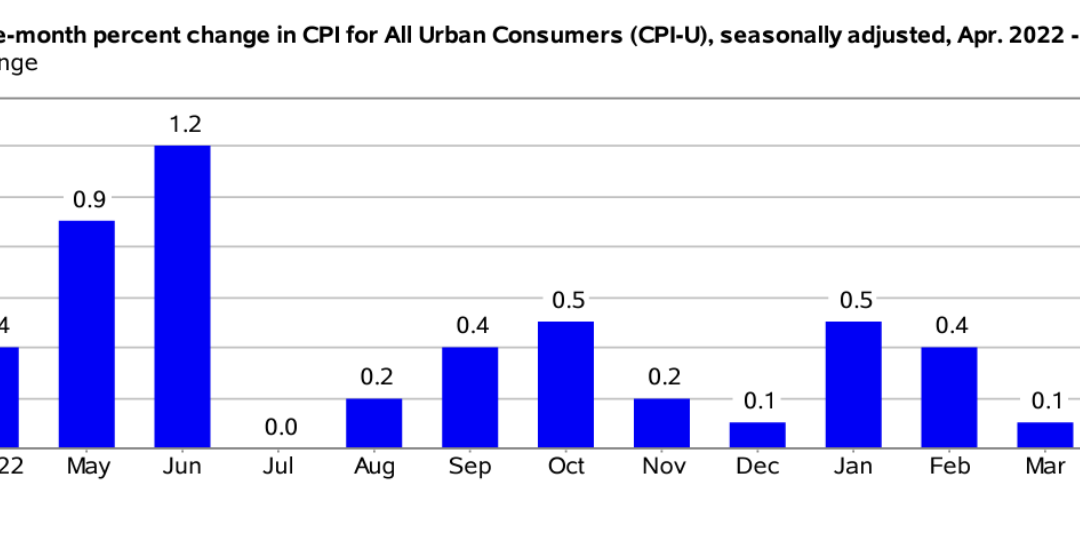
by Liam Hunt | May 10, 2023 | Monthly CPI Updates
The Consumer Price Index for All Urban Consumers (CPI-U) increased by 0.4% on a seasonally unadjusted basis in April 2023, according to the Bureau of Labor Statistics report published May 10. Year-over-year, before seasonal adjustment the all-items index grew by 4.9%, which is slightly down from 5.0% in March.
Overall, the April 2023 CPI report came in better than expected for market watchers. Independent observers generally expected a steady inflation rate of 5.0% for April, so the slightly better-than-expected results of 4.9% generated a jump of 150 points in the Dow Jones.
This month’s CPI report indicates that the Federal Reserve’s hawkish monetary policy is working as intended, as inflation has been continually trending downward for the better part of a year. However, there remains a long road ahead to get to the 2.0% target rate that the Fed has maintained as a policy aspiration.
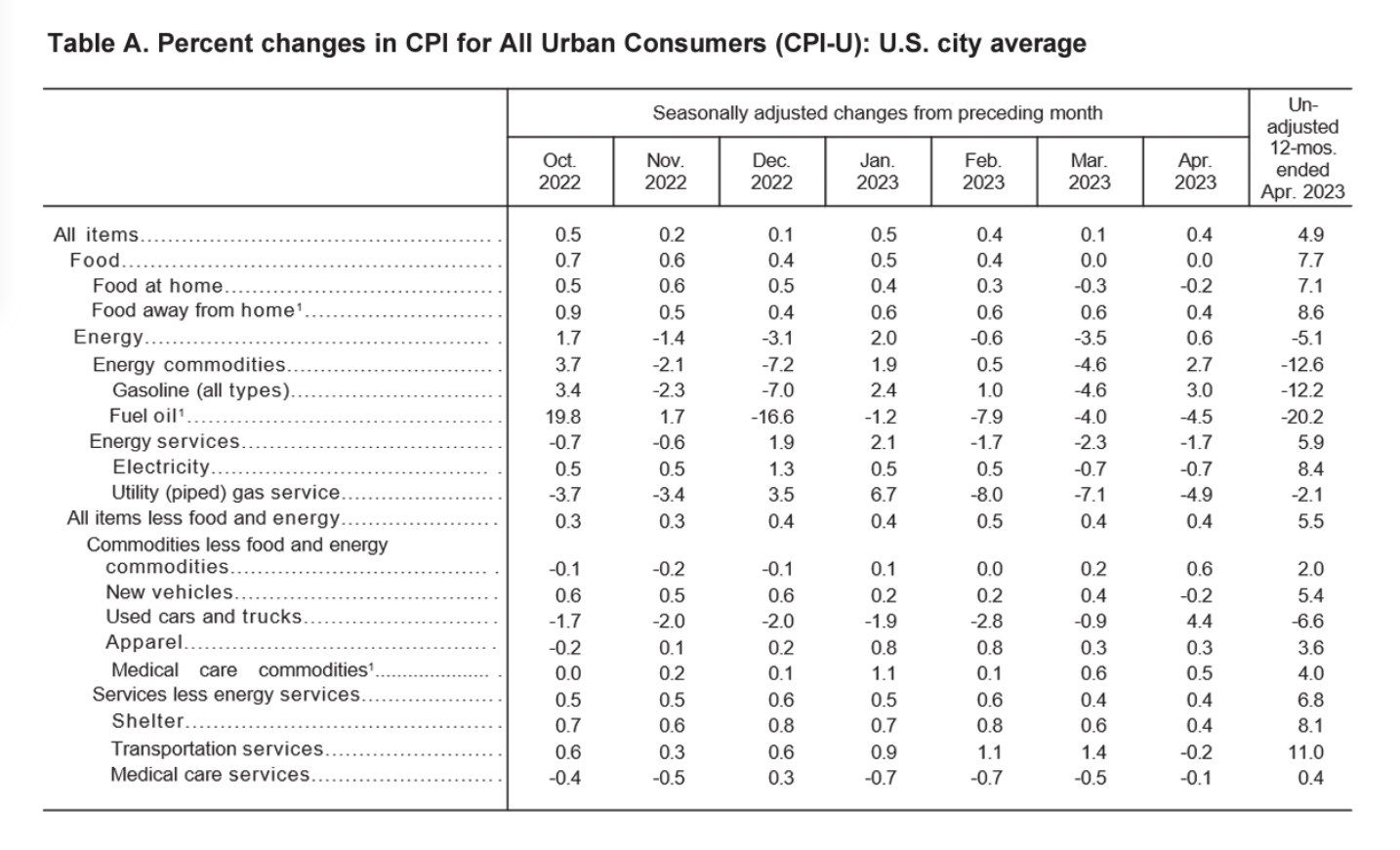
Source: Bureau of Labor Statistics
April’s monthly CPI figure (0.4) came in significantly higher than the previous month’s (0.1). This is due to the fact that March 2022 saw significant increases in oil, gas, and natural resource prices during the early days of the Russian invasion of Ukraine, creating a skewed base-year effect.
Overall, heightened consumer costs for shelter, used cars and trucks, and gasoline were the main drivers behind April’s 2023 CPI increase.
Food Prices
The food index went unchanged in April, while the food at home index fell (-0.2%), which is a deceleration from the previous month’s drop of (-0.3%). Fortunately for American families, four out of six grocery indices fell in April, providing some relief at the supermarket checkout. Notably, fruits and vegetables fell (-0.5%), and meats, poultry, fish, and eggs fell as well (-0.3%).
By contrast, certain food items increased in price. Most notable were cereals and bakery goods, which increased (+0.2%) in April, although they rose by an even higher margin during the previous month (+0.4%).
Energy Prices
Energy costs rose in April (+0.6%) after falling (-3.5%) in March. Gasoline, in particular, rose by +3.0% whereas the natural gas index declined (-12.2%) on the year. At the same time, the fuel oil index also dropped off precipitously (-20.2%) while electricity costs rose by +8.4%. In other words, energy costs either rose or fell by varying margins depending on the segment of the market and the specific energy type.
Core April 2023 CPI
The core CPI data for April 2023, which refers to the monthly CPI figure less food and energy, rose 0.4% month-over-month in April, matching its pace in March. Below, we’ve shared a brief breakdown of the main price movements seen within April’s core CPI reading:
- Shelter index: +0.4% (+0.6% in March)
- Used cars and trucks: +4.4%
- Motor vehicle insurance: +1.4%
- Airline fares index: (-2.6%)
- New vehicles: (-0.2%)
- Medical care index: (-0.3%)
- Shelter index: +8.1% (comprising 60% of the core CPI’s total increase)
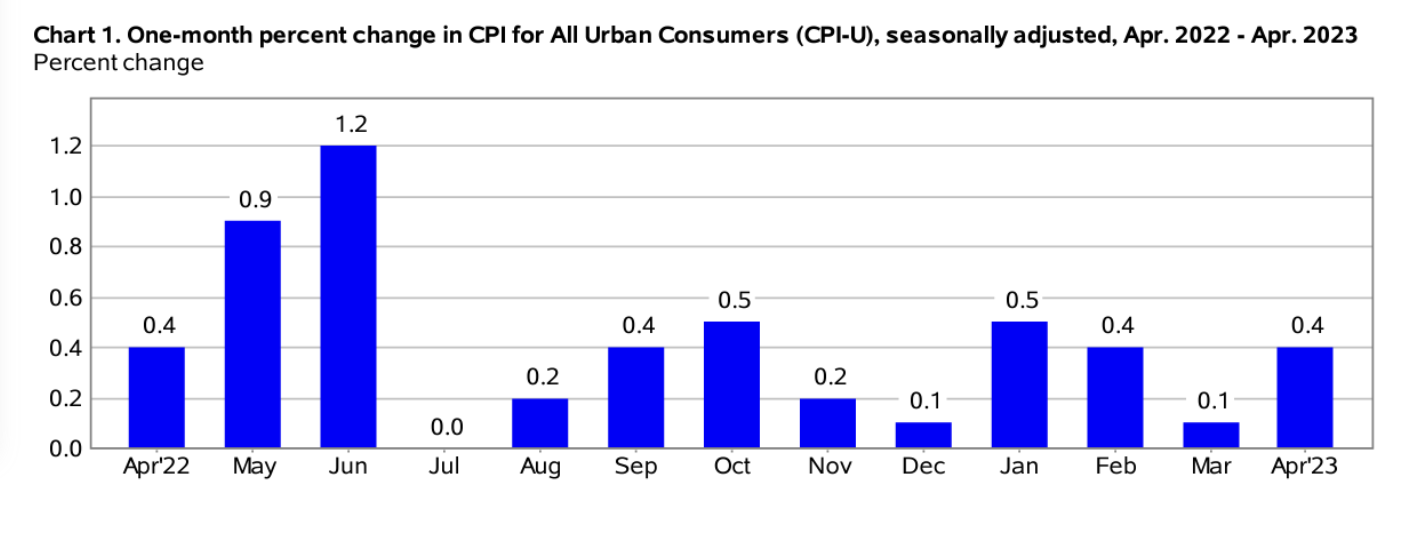
Source: Bureau of Labor Statistics
Seasonally Unadjusted CPI Data for April 2023
Prior to seasonal adjustment, the CPI-U data for the month increased (+0.5%), rising to an index level of 303.363. Due to their unadjusted nature, these data include normal price fluctuations that regularly occur at the same time and by the same margins every year.
Protect Your Portfolio from Inflation in 2023
Every month, the U.S. dollar loses value, and the relative purchasing power of the American consumer declines. To combat the negative effects of inflation, consider speaking to your financial advisor about diversifying your investment portfolio with alternative assets that may help insulate your savings from the devaluation effects of inflation.
Hard assets such as gold and silver have historically performed well during periods of economic uncertainty and high inflation. As an inflation hedge, its often sought after by investors looking to actively manage risk in their investment strategy. To get started with gold or silver investing, consider opening an account with one of America’s best gold IRA service providers. The current top-ranked provider of gold IRAs is Noble Gold—you can read an exclusive review of Noble Gold here.
To keep tabs on inflation in the months ahead, don’t forget to use our exclusive CPI inflation calculator tool to see how macroeconomic conditions are affecting your purchasing power.

by Liam Hunt | Apr 12, 2023 | Monthly CPI Updates
The Consumer Price Index for All Urban Consumers (CPI-U) increased by 0.1% on a seasonally adjusted basis, per the Bureau of Labor Statistics. Year-over-year, before seasonal adjustment the all-items index grew by 5.0%, which is down from 6.0% in February.
March’s CPI data is in step with a continuing trend of inflation deceleration that has been ongoing all year after peaking at 9.1% in June of last year. According to a Yahoo Finance report, consumer prices in March came in less than expected, which was around 5.2%.
In short, the March 2023 CPI-U data indicates a cool-off is still underway, with deceleration trending toward the Fed’s target rate of 2.0% by next year.
Shelter costs were the major driving force in March’s inflation figure. Although the energy index declined in March and the food index remained unchanged from last month, the index for all items less food and energy rose 0.4%. Overall, the March 2023 CPI increase (5.0%) constituted the smallest year-over-year (Y-o-Y) increase since May 2021.

Source: Bureau of Labor Statistics
As indicated in “Table A” below, energy prices, including gasoline, as well as used cars and trucks put significant downward price pressure on the CPI in the month of March. Meanwhile, food at home (8.5%), food away from home (8.8%), and transportation services (13.9%) asserted a lot of upward pressure that more than offset the price reductions in the energy sector.
Most significant is the drop in energy prices which, compared to February 2023, saw dramatic price drops. This can largely be attributed to the major price increases in oil and gas following the Russian invasion of Ukraine in March of last year.
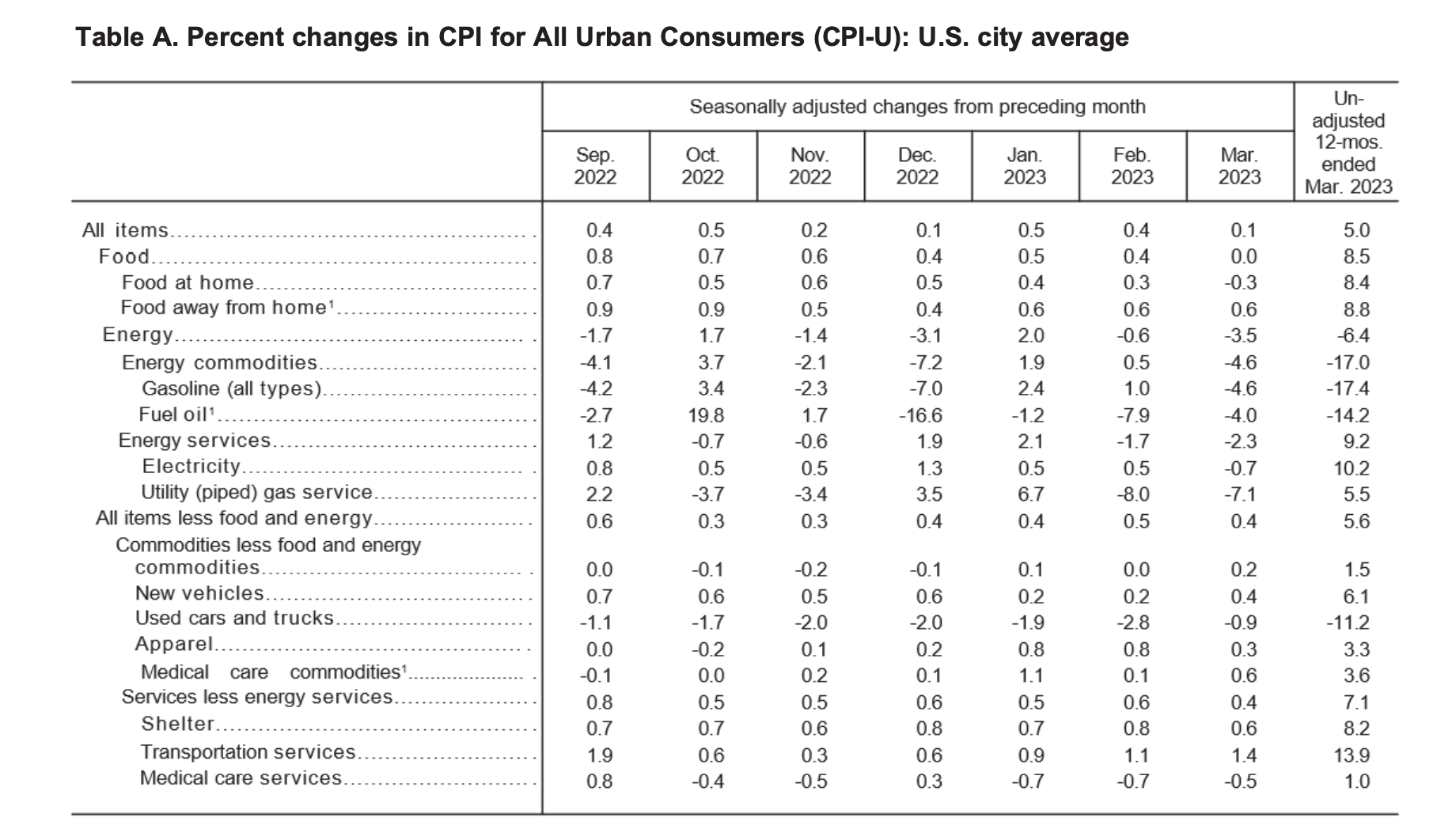
Largest Y-o-Y Drop Since May 2021
The most important story in the March 2023 CPI report is that inflation is dramatically cooling off from its mid-2022 high point. In fact, this month saw the smallest Y-o-Y increase in the CPI-U since May 2021. This appears to indicate that the Federal Reserve’s hawkish interest rate policy appears to be working as intended, and that future rate hikes are likely to continue (albeit at a slower pace) until the target 2% inflation benchmark is reached.

Core CPI Still Cause for Concern
Overall, the core CPI (CPI-U less food and energy) is still hot, coming in at 0.4% after a 0.5% increase in February. This is due primarily to rent increases and increases in the homeowners’ equivalent rent indices increasing by 0.5% in March. Therefore, policymakers are likely to target rent and housing affordability concerns through legislative efforts in order to mitigate the negative effects of housing costs on the CPI.
Ready to Protect Your Retirement Savings?
While inflation appears to be cooling, high interest rates and cost-of-living increases are taking a toll on the average American family. With inflation still far above the Fed’s target benchmark, investors are losing more and more of their savings every year due to the depreciation of the U.S. dollar.
Want to learn more about how inflation is impacting American households? Check out our exclusive calculator widget, and don’t forget to subscribe to our monthly newsletter if you haven’t already—this way, you can stay informed of the latest CPI developments immediately after they’re released.
Source Cited: https://www.bls.gov/news.release/pdf/cpi.pdf





















